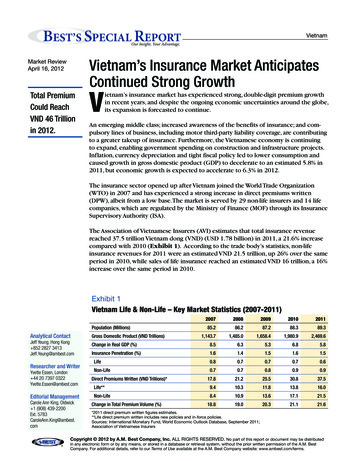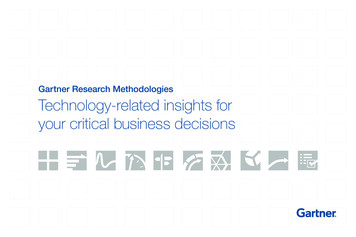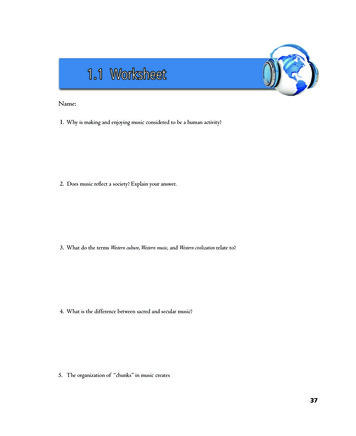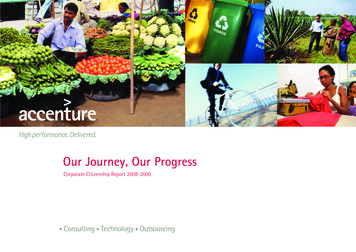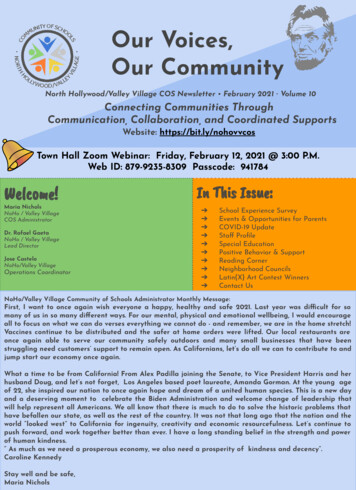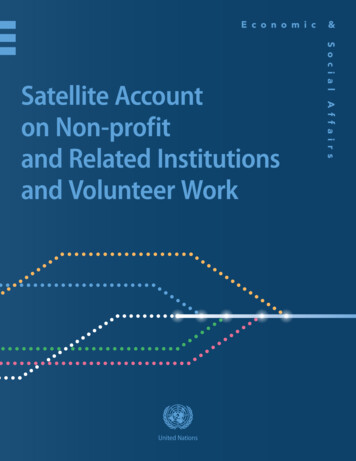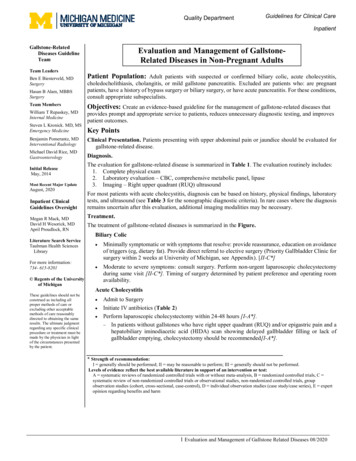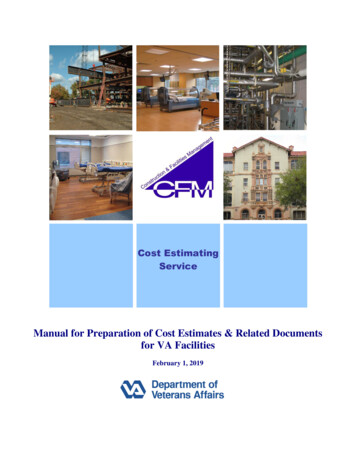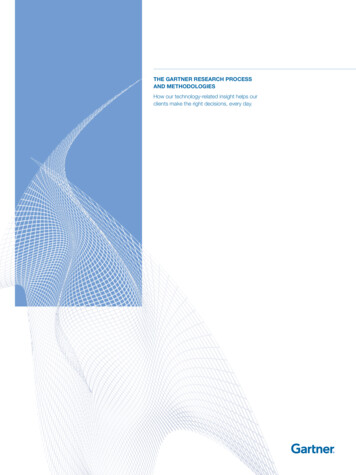
Transcription
THE Gartner Research ProcessAND MethodologiesHow our technology-related insight helps ourclients make the right decisions, every day.
WHY RESEARCH MATTERSClients like you have spoken loud and clear:Why do you need research?You want to understand the thought processes,Your decisions, especially those that enableyour organization’s unique strategy, have longlasting impact, often for years to come. Theyneed to be backed and informed by researchyou can trust. At Gartner, our promise is to helpyou make better, more informed decisions abouthow you use technology to your advantage.logic, assumptions and methodologies weuse to formulate our research and conclusions.You care about the quality, independence andrigor behind our research engine, and youexpect transparency in understanding howit works.
“Gartner is an intelligent filter for the oceans of information I need to track and monitor.With Gartner research and methodologies, I get opinions that are objective, unbiased and candid.”CIOSports Apparel ManufacturerIT is the businessWe help you decide with confidenceOur clients are converging IT andbusiness strategy like never before.And the opportunities just keep coming.Developments in enterprise mobility,business intelligence, consumer technology,virtualization and SOA are presenting newinvestment options every day. Informationabout how IT enables innovation is plentiful;but insight you can trust to make betterdecisions relevant to your unique situationis in much shorter supply. That’s whereGartner comes in.Gartner was founded in 1979 as aresearch firm to provide clients withunbiased, independent advice regardingtheir major IT purchases. Thirty yearslater, we are still the industry leader.Clients continue to trust our rich heritage,our vast knowledge network and ourunique research process and proprietarymethodologies to help them make moreconfident decisions every day.1
a way of thinkingOur experienced analysts adhereto a research process and set ofmethodologies built on principleswe consider non-negotiable.SCENARIOSSEARCH &VERIFYSURVEYSPEER &FACTUALREVIEWSTALKINGHORSEPATTERNRECOGNITIONOur research process turns complexinformation into actionable advice you canApplicable across many rolesuse for business advantage. Its underlyingPerhaps you’re a chief information officer, an enterprise architect or an infrastructure manager. Maybeyou provide commercial IT solutions or invest intechnology companies. In all cases, our researchprocess and unique methodologies help you answercritical questions such as:methodologies are a tested set of researchpractices, procedures and rules used tocollect and analyze information.Clients like you depend on the integrity andreliability of our methodologies to support thedecisions you make in your role every day.You rely on the experience and expertise ofour analysts to help you interpret patterns,aid your understanding of emerging businessmodels and apply technology for innovation.2 What are the most urgent priorities of today’sbusiness and technology leaders? What types ofmanagement techniques and best practices arepaying off for them? Which emerging technologies have the mostcommercial promise? What types of productivitybreakthroughs or revenue streams will they impact? How do the buying intentions of Global 1000companies map to technology provider strategies?Which emerging players have the staying powerto rise to the top of their respective sectors?
Driven by an experienced analyst community Rigorous. We are scrupulous in ensuring thatthe research practices we follow deliver insightsthat are relevant, appropriate and practical foryour business. Independent and unbiased. Our process,methodologies and policies are designed toensure that no one’s personal agenda drivesthe results. Systematic. Our process and methodologiesfollow a consistent, logical and consideredsequence. We don’t take shortcuts; we developsolutions that work. Reviewed and evaluated by peers. All ofour written research and presentations getpeer-reviewed to inject the most current thinkingabout recent events and their potential impact. Valid. Our opinions are grounded in a solid baseof facts verified by our own experienced analystsand others in business and academia. Empirical. Our conclusions are based on thehard evidence we collect—through our analystsand market surveys—from the real-life experiencesof our clients (who number 60,000 across10,000 distinct organizations worldwide).3
ITSCORESAdvancing IT Organizational PerformanceAgainst Enterprise GoalsGartner ITScores are holistic sets ofinteractive maturity assessments designedto help CIOs and IT leaders evaluate thematurity of both the IT organization as aprovider of IT services, and the enterprise asa consumer of information technology.Unlike other IT maturity assessments, aGartner ITScore measures your organization’scapabilities within the context of enterpriseculture, behaviors and capacity forleadership—factors that dramatically impactIT’s effectiveness and its ability to contributereal business value.HOW DO ITSCORES WORK?ITScores are based on three components:Organizational Questions, CIO Survey andRole Surveys.1. Organizational Questions, inconjunction with at least one ofthe CIO/Role surveys, capture howwell your enterprise leverages ITto improve business outcomes.2. CIO Survey evaluates your ITorganization from a managerial andleadership perspective.3. Role Surveys assess eightindividual roles and disciplines withinyour IT organization, measuringthe effectiveness of IT leaders indeveloping and exploiting core ITorganizational capabilities.4Take as many of the available surveysas you choose. The more surveys yourorganization completes, the moreaccurate your results and the moreapplicable the recommendations.Surveys can be taken more thanonce to track progress, and the toolsupports what-if scenarios that can bestored for later reference.Each time you take the OrganizationalQuestions survey in conjunction withat least one of the CIO/Role surveys,you receive a maturity score andrecommendation report for the specificcapability or perspective examined,as well as an enterprise IT maturityscore and accompanying explanation.The enterprise IT maturity score isupdated and refined with each linked,completed ITScore survey.
HOW DO YOUUSE ITSCORES?Your ITScore provides a holistic view that goesbeyond functional/role disciplines to arrive at anuanced, comprehensive assessment that is trulydiagnostic and produces meaningful recommendedactions. The ITScore differs from other maturitymodels in important ways: It not only examines IT leadership effectivenessand incorporates business behaviors, perceptionsand expectations, but also tests how yourcapabilities are integrated and their combinedpower leveraged for enterprise advantage. It is outcome-oriented. Maturity models usuallyfocus on attributes and have little to say aboutwhether they are good or bad or how theycontribute to desired results. Your ITScorefocuses not just on attributes but also oncontribution and results. It is practical. Real maturity is neither linear norunidirectional. Achieving a state of near-perfectionin key processes or attributes can actually havenegative consequences. Your ITScore takes thisinto account. Gartner provides complementary research thathelps you understand where you should be onthe maturity score based on business realities,not just where you are or what is required toadvance. Other maturity models fall short here,leading enterprises to conclude that higher levelsof maturity are always “better.”ITSCORES HELP YOU: Gain insights into what you want toaccomplish, where you are today indeveloping the necessary capabilities,and the actions needed to close gapsand advance Assess and compare maturity across ITdisciplines, and leverage best practicesthroughout the organization Provide an objective basis forcross-functional communication,collaboration and planning5
IT MARKET CLOCKsProviding a Full Life Cycle View ofTechnology AssetsThe useful life of every technology product orservice has an end, beyond which it will bemore cost-effective to retire and replace theasset than to continue maintaining it. GartnerIT Market Clocks are decision frameworksthat provide a full life cycle view of technologyassets—whether capabilities, products orservices. They help you better evaluate thetechnology assets you are responsible for,so you can prioritize IT investments andbuild technology road maps that supportbusiness plans.HOW DO IT MARKET CLOCKS WORK?IT Market Clocks use a clock-face metaphor torepresent relative market time. Each point onthe clock represents an IT asset or asset class.An asset is positioned on the clock using twoparameters:6Where it currently lies within its usefulmarket life. Each clock begins at 0 (the“Market Start”) and moves clockwisearound to 12.Choice—assets in themass-customized phase, subject toincreasing levels of standardization andgrowing supply optionsI ts relative level of commoditization.This determines the distance from thecenter of the clock—assets furtherfrom center are more commoditized.Cost—assets in the commoditizedphase, where differentiation betweenalternative sources is at its minimumlevel and competition centers on priceThe clock is divided into quarters, eachrepresenting one of the market phasesof an asset’s useful life. The quartersare named to highlight the generalapproach recommended for assetspassing through that phase:Replacement—assets in thedisfavored phase, usually legacytechnologies, services or capabilitiesAdvantage—assets in thecustomized phase, which providedifferentiated technology, serviceor capabilityA Market Clock RecommendationSummary provides a tabularsummary of the positions andexpected trajectory for each IT assetor asset class, as well as specificrecommendations.
“We see potential in applying the Gartner IT Market Clock methodology to transform our purchasing process bytreating emerging IT assets differently from mature or commoditized assets and by enabling a more effectivedialogue between the many stakeholders in the IT decision process.”CIO Office, Operational Planning and Client ManagementEuropean Business Services ProviderHOW DO YOU USEIT MARKET CLOCKS?The way an organization invests in, deploys,manages and approaches technology assetsshould change during the asset’s useful life. IT andbusiness leader clients use IT Market Clocks asdecision frameworks to help them evaluate andprioritize their IT investments.Understanding how each asset is progressingthrough its useful life allows you to makeinformed investment decisions. IT Market Clocksare complementary to Gartner Hype Cycles. Inessence, Hype Cycles support technology“hunting” decisions, while IT Market Clocks support“farming” decisions for assets already in use.Designed to support multiple IT roles and functions,the IT Market Clock provides a consolidated viewof IT assets within a specific portfolio and canassist with portfolio balancing, project prioritizationand the development of business cases forinvestment/divestment.Examples of how the IT Market Clock is usedinclude: Development of business cases to replaceaging infrastructure The establishment of principles for bringingoutsourced support services back in-houseas underlying technology enters its replacementphaseIT MARKET CLOCKS HELP YOU: Gain a full life cycle view of yourtechnology assets Evaluate and prioritize your ITinvestments Build technology road maps thatsupport business plans7
Hype CyclesInterpreting Technology HypeWhen new technologies make bold promises,how do you discern the hype from what’scommercially viable? And when will suchPEAK OF INFLATEDEXPECTATIONSclaims pay off, if at all? Gartner Hype Cyclesprovide a graphic representation of thematurity and adoption of technologies andrelevant to solving real business problemsand exploiting new opportunities. GartnerHype Cycles help you understand how aVISIBILITYapplications, and how they are potentiallySLEOPOFENHLI GTENMENTPLATEAU OFPRODUCTIVITYtechnology or application will evolve overtime, providing a sound source of insight tomanage its deployment within the context ofTECHNOLOGYTRIGGERTROUGH OFDISILLUSIONMENTyour specific business goals.MATURITYHOW DO HYPE CYCLES WORK?Each Hype Cycle drills down into the five keyphases of a technology’s life cycle:Technology Trigger. A potentialtechnology breakthrough kicks thingsoff. Early proof-of-concept stories andmedia interest trigger significant publicity. Often no usable products exist, andcommercial viability is unproven.Peak of Inflated Expectations.Early publicity produces a number ofsuccess stories—often accompaniedby scores of failures. Some companiestake action; many do not.8Trough of Disillusionment. Interestwanes as experiments and implementations fail to deliver. Producers of thetechnology shake out or fail. Investments continue only if the survivingproviders improve their products tothe satisfaction of early adopters.Slope of Enlightenment. Moreinstances of how the technology canbenefit the enterprise start to crystallizeand become more widely understood.Second- and third-generation productsappear from technology providers.More enterprises fund pilots; conservative companies remain cautious.Plateau of Productivity. Mainstreamadoption starts to take off. Criteria forassessing provider viability are moreclearly defined. The technology’s broadmarket applicability and relevance areclearly paying off.
“A Gartner Hype Cycle that shows how technology is reshaping the payment business and how competitorsare attacking banking’s traditional domain gets executives to sit up in their chairs and listen.”Executive Vice PresidentIT Services and Management Consulting FirmHOW do you usehype cycles?Clients use Hype Cycles to get educated aboutthe promise of an emerging technology within thecontext of their industry and individual appetitefor risk.Should you make an early move? If you’re willingto combine risk taking with an understanding thatrisky investments don’t always pay off, you couldreap the rewards of early adoption.Is a moderate approach appropriate? Executiveswho are more moderate understand the argumentfor an early investment but will also insist on asound cost/benefit analysis when new ways ofdoing things are not yet fully proven.Should you wait for further maturation? If thereare too many unanswered questions around thecommercial viability of an emerging technology, itmay be better to wait until others have been ableto deliver tangible value.Hype Cycles help you: Separate hype from the real drivers ofa technology’s commercial promise Reduce the risk of your technologyinvestment decisions Compare your understanding of a technology’s business value with the objectivity of experienced IT analysts9
magic quadrantsPositioning Technology Players Within aSpecific MarketWho are the competing players in themajor technology markets? How are theypositioned to help you over the long haul?of research in a specific market, giving youa wide-angle view of the relative positionsof the market’s competitors. By applyinga graphical treatment and a uniform set ofevaluation criteria, Gartner Magic QuadrantsCHALLENGERSLEADERSNICHE PLAYERSVISIONARIESABILITY TO EXECUTEGartner Magic Quadrants are a culminationquickly help you digest how well technologyproviders are executing against theirstated vision.COMPLETENESS OF VISIONhow do magic quadrants work?Magic Quadrants provide a graphical competitivepositioning of four types of technology providers,where market growth is high and providerdifferentiation is distinct:10Challengers execute well today ormay dominate a large segment, but donot demonstrate an understanding ofmarket direction.Niche Players focus successfully ona small segment, or are unfocusedand do not out-innovate or outperformothers.Leaders execute well against theircurrent vision and are well positionedfor tomorrow.Visionaries understand where themarket is going or have a vision forchanging market rules, but do not yetexecute well.
“Gartner Magic Quadrants have helped guide our strategic actions for capturing leadership positionsin contact center infrastructure, interactive voice response and enterprise voice portals.”President and CEOContact Management Software Companyhow do youuse magicquadrants?Clients use Magic Quadrants as a first step tounderstanding the technology providers they mightconsider for a specific investment opportunity.Keep in mind that focusing on the leaders’ quadrantisn’t always the best course of action. There aregood reasons to consider market challengers. Anda niche player may support your needs better thana market leader. It all depends on how the provideraligns with your business goals.magic quadrants help you: Get quickly educated about a market’scompeting technology providers andtheir ability to deliver on what end usersrequire today and in the future Understand how a market’s technologyproviders are competitively positionedand the strategies they are using tocompete for end-user business Compare a technology provider’sstrengths and challenges with yourspecific needs11
maRKETSCOPESUnderstanding Emerging andMature MarketsWhen markets are growing and IT solutionsare stable, Magic Quadrants provide theSTRONGNEGATIVEbest tool for understanding how the playersare competitively positioned. But when newPROMISINGPOSITIVESTRONGPOSITIVEVENDOR PRODUCT/SERVICE AVENDOR PRODUCT/SERVICE Bmarkets emerge and user requirements are inVENDOR PRODUCT/SERVICE Cflux, solutions are often approached in wildlyVENDOR PRODUCT/SERVICE Ddifferent ways, making a competitive posi-CAUTIONVENDOR PRODUCT/SERVICE EVENDOR PRODUCT/SERVICE Ftioning less useful. Mature markets presenta similar challenge, as the differentiatorsamong consolidating technology providersand solutions grow more difficult to discern.how do marketscopes work?12A MarketScope rates a market itselfand helps you evaluate its participatingtechnology providers against theGartner vision for that market.MarketScopes rate each market’stechnology providers as StrongPositive, Positive, Promising, Cautionor Strong Negative.
“We believed we had an opportunity to innovate in our market with a next-generation tool,but we needed to scope the market. With help from Gartner, we got the market validationand insight we needed to launch a unique solution that would rise above the market noise.”CEOSoftware and Professional Services Companyhow do you usemarketscopes?Clients use MarketScopes to understand how thestatus of an emerging or mature market aligns withtheir own state of maturity and future plans.For example, should you invest in emerging marketsolutions that appear innovative but are potentiallyrisky? On the flip side, should you begin retiringyour investments in market solutions that havematured?maRKETSCOPES help you: Manage the risk of investing in bothemerging and mature markets, and whatlevel of promise their future holds Support the argument for allowing anemerging market to further evolve beforeyou invest, or support decisions to retireyour investments in solutions that havematured Understand how technology providersin both market types are performingand which criteria play a key role in theirsurvival13
vendor ratingsTracking and Monitoring ProviderPerformanceClients use our well-defined methodology toSTRONG POSITIVErate IT technology providers—large, small,public or private. Gartner Vendor Ratingsassess all the different aspects of aPOSITIVEtechnology provider, such as its strategy,organization, products, technology, marketing,financials and support. These ratings arePROMISINGperiodically revised to reflect changes inassessment when a significant internal orexternal event directly affects the provider.CAUTIONSTRONG NEGATIVEHOW DO vendor ratings work?Technology providers with a clear focus, solid products and an advantageous market position may berated Positive or Strong Positive.
Gartner comes in. “Gartner is an intelligent filter for the oceans of information I need to track and monitor. With Gartner research and methodologies, I get opinions that are objective, unbiased and candid.” CIO Sports Apparel Manufacturer We help yo
